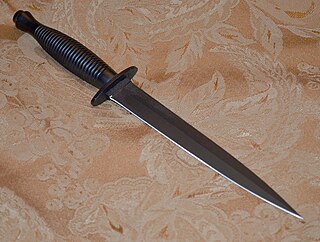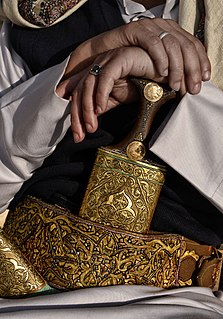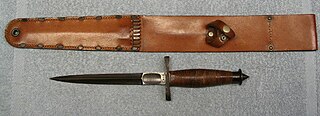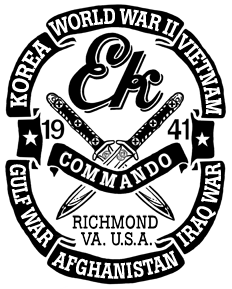
A utility knife is any type of knife used for general manual work purposes. Such knives were originally fixed-blade knives with durable cutting edges suitable for rough work such as cutting cordage, cutting/scraping hides, butchering animals, cleaning fish scales, reshaping timber, and other tasks. Craft knives are small utility knives used as precision-oriented tools for finer, more delicate tasks such as carving and papercutting.

A dagger is a fighting knife with a very sharp point and usually two sharp edges, typically designed or capable of being used as a thrusting or stabbing weapon. Daggers have been used throughout human history for close combat confrontations, and many cultures have used adorned daggers in ritual and ceremonial contexts. The distinctive shape and historic usage of the dagger have made it iconic and symbolic. A dagger in the modern sense is a weapon designed for close-proximity combat or self-defense; due to its use in historic weapon assemblages, it has associations with assassination and murders. Double-edged knives, however, play different sorts of roles in different social contexts.

A knife is a tool or weapon with a cutting edge or blade, usually attached to a handle or hilt. One of the earliest tools used by humanity, knives appeared at least 2.5 million years ago, as evidenced by the Oldowan tools. Originally made of wood, bone, and stone, over the centuries, in step with improvements in both metallurgy and manufacturing, knife blades have been made from copper, bronze, iron, steel, ceramic, and titanium. Most modern knives have either fixed or folding blades; blade patterns and styles vary by maker and country of origin.

A switchblade (aka switch knife, automatic knife, pushbutton knife, ejector knife, flick knife, flick blade, or spring knife is a type of knife with a sliding or pivoting blade contained in the handle which is extended automatically by a spring when a button, lever, or switch on the handle or bolster is activated. Virtually all switchblades incorporate a locking blade, where the blade is locked against accidental closure when the blade is in the open position. It is unlocked by a mechanism that allows the blade to be folded and locked in the closed position.

A butterfly knife, also known as a Balisong, fan knife or Batangas knife, is a type of folding pocketknife that originated in the Philippines. Its distinct features are two handles counter-rotating around the tang such that, when closed, the blade is concealed within grooves in the handles. A latch holds the handles together, typically mounted on the one facing the cutting edge.

The sgian-dubh – also anglicized as skene – is a small, single-edged knife worn as part of traditional Scottish Highland dress along with the kilt. Originally used for eating and preparing fruit, meat, and cutting bread and cheese, as well as serving for other more general day-to-day uses such as cutting material and protection, it is now worn as part of traditional Scottish dress tucked into the top of the kilt hose with only the upper portion of the hilt visible. The sgian-dubh is normally worn on the same side as the dominant hand.

A trench knife is a combat knife designed to kill or incapacitate an enemy at close quarters, such as in a trench or other confined area. It was developed as a close combat weapon for soldiers attacking enemy trenches during the First World War. An example of a World War I trench knife is the German Army's Nahkampfmesser.

A boot knife or a gambler's dagger is a small fixed-blade knife that is designed to be carried in or on a boot. Typically, such a knife is worn on a belt or under a pant leg. If worn around the neck they become a neck knife. Boot knives generally come with a sheath that includes some form of a clip. Most have double-edged blades, like a dagger, that range from 3 to 5 inches.

The SOG Knife was designed for, and issued to, covert Studies and Observations Group personnel during the Vietnam War. It was unmarked and supposedly untraceable to country of origin or manufacture in order to maintain plausible deniability of covert operators in the event of their death or capture.

Japanese sword mountings are the various housings and associated fittings that hold the blade of a Japanese sword when it is being worn or stored. Koshirae (拵え) refers to the ornate mountings of a Japanese sword used when the sword blade is being worn by its owner, whereas the shirasaya is a plain undecorated wooden mounting composed of a saya and tsuka that the sword blade is stored in when not being used.

A jambiya, also spelled janbiya, jambya, jambia and janbia, is a specific type of dagger with a short curved blade with a medial ridge that originated from Yemen. They have spread all over the Middle East as well as South Asia and Southeast Asia. Men typically above the age of 14 wear it as an accessory to their clothing.

A facón is a fighting and utility knife widely used in Argentina, Brazil, and Uruguay as the principal tool and weapon of the gaucho of the South American pampas. Often fitted with an elaborately decorated metal hilt and sheath, the facón has a large, heavy blade measuring from 25 cm to 51 cm in length.

A push dagger is a short-bladed dagger with a "T" handle designed to be grasped and held in closed-fist hand, so that the blade protrudes from the front of the fist, either between the index and middle fingers, or between the two central fingers, when the grip and blade are symmetrical. Less often also called push dirk, which although a dirk is also a relatively short, close-combat thrusting blade, it is normally a long-bladed thrusting dagger.

The V-42 stiletto was a stiletto and fighting knife issued during World War II to the First Special Service Force, a joint American/Canadian commando unit.

Ek Commando Knife Co. or Ek Knives is an American combat knife brand produced by several different companies since the original founded by John Ek in 1941. In May 2014 the Ek brand was purchased by Ka-Bar which began selling its versions of Ek knife designs in 2015. Although not officially issued gear, Ek Knives have seen use by US forces in six major conflicts: World War II, the Korean War, the Vietnam War, the Gulf War, Afghanistan, and the Iraq War. Ek Knives manufactures Bowie-style blades, daggers, and a Fairbairn-Sykes MkII. President Franklin Delano Roosevelt, Clark Gable, and General George S. Patton have been identified as Ek knife owners.

The M3 trench knife or M3 fighting knife was an American military combat knife first issued in March 1943. The M3 was originally designated for issue to soldiers not otherwise equipped with a bayonet. However, it was particularly designed for use by forces in need of a close combat knife, such as Airborne Units and Army Rangers, so these units received priority for the M3 at the start of production. As more M3 knives became available in 1943 and 1944, the knife was issued to other soldiers such as Army Air Corps crewmen and soldiers not otherwise equipped with a bayonet, including soldiers issued the M1 carbine or a submachine gun such as the M3 “grease gun.”

Ka-Bar is the contemporary popular name for the combat knife first adopted by the United States Marine Corps in November 1942 as the 1219C2 combat knife, and subsequently adopted by the United States Navy as the U.S. Navy utility knife, Mark 2. Ka-Bar is the name of a related knife manufacturing company, Ka-Bar Knives., Inc., of Olean, New York, a subsidiary of the Cutco Corporation.

The pesh-kabz or peshkabz is a type of Indo-Persian knife designed to penetrate mail armour and other types of armour. The word is also spelled pesh-qabz or pish-ghabz and means "fore-grip" in the Persian language; it was borrowed into the Hindustani language. Originally created during Safavid Persia, it became widespread in Central Asia and the Indian subcontinent during Mughal period.

A fighting knife has a blade designed to most effectively inflict injury in close-quarters physical confrontations. The combat knife and the trench knife are examples of military fighting knives.

The piha kaetta, also sometimes called 'the Kandyan knife', is a knife or dagger native to the island of Sri Lanka. A typical piha kaetta has a straight-backed blade combined with a drop-point and a curved cutting edge. Many of the finest piha kaetta knives were produced in royal workshops, show very high levels of craftsmanship, and were given to courtiers and the nobility as status symbols.




















